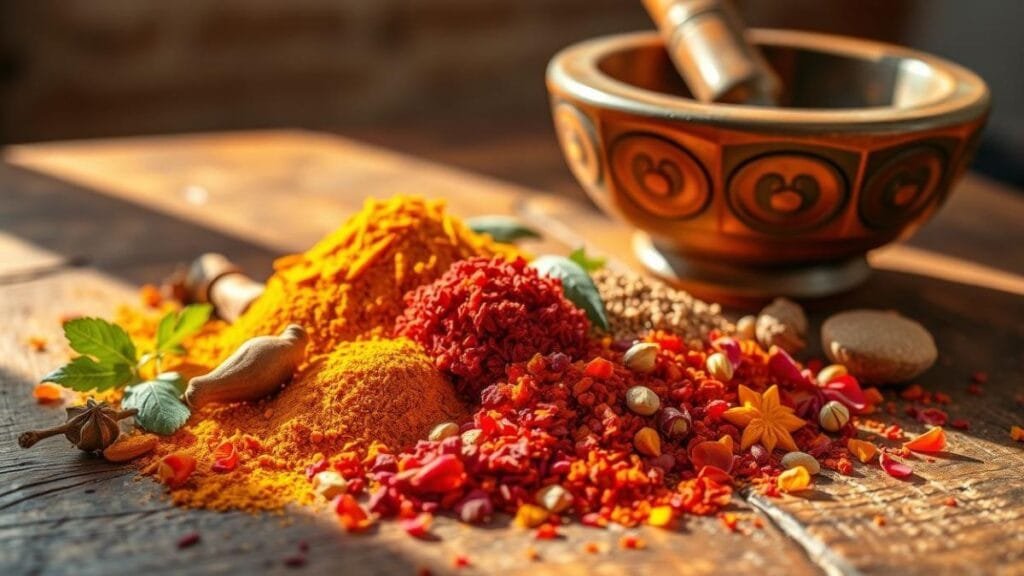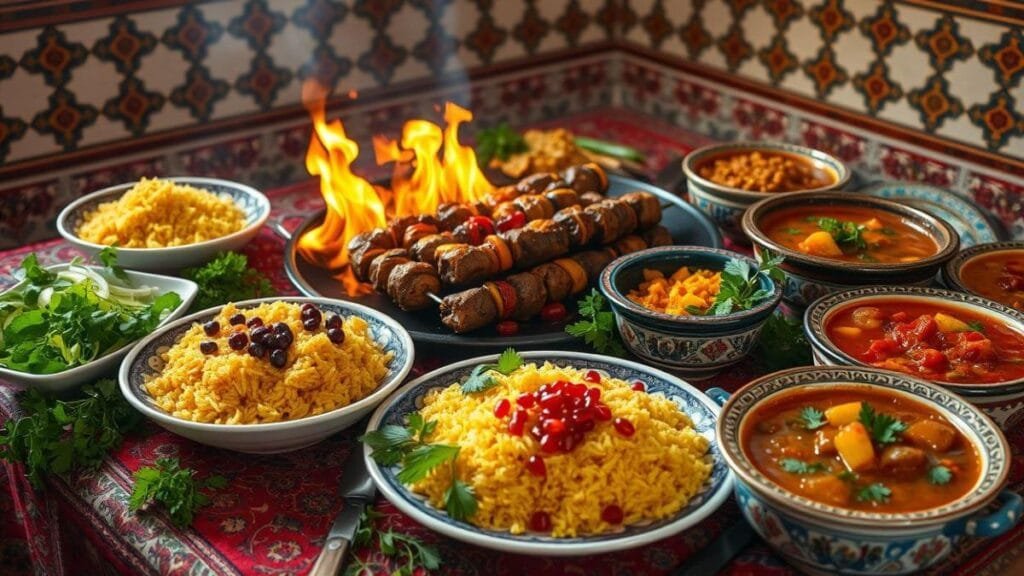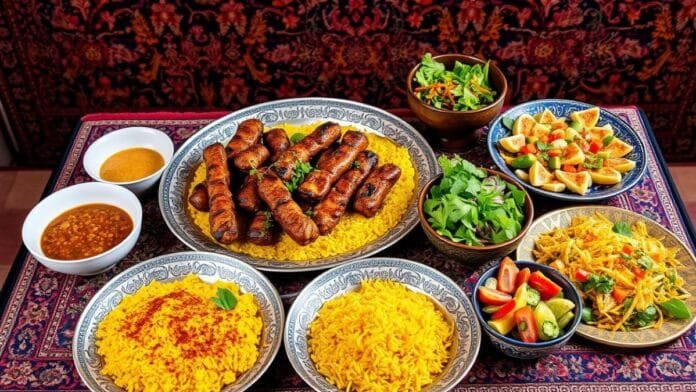As a child, I remember the smells in my grandmother’s kitchen. The sizzle of saffron-scented rice and the earthy stews were unforgettable. The spices added a special touch to every dish. Now, I’m excited to share these authentic Iranian recipes with you.
Persian food is a mix of old traditions and new tastes. You’ll find dishes like Kotlet (Persian Patties) and Shirazi Salad. These recipes are easy to make and full of the flavors my grandmother loved. Whether you’re a pro in the kitchen or just starting, you can make these dishes at home.
Persian Cuisine: A Rich Cultural Heritage
Persian cuisine has a long history, over 3,000 years old. It started in the vast Persian Empire. This empire introduced many spices and cooking methods that shaped Middle Eastern food. The flavors of traditional Iranian cuisine reflect the region’s vibrant cooking heritage, with aromas from saffron and cardamom mingling with tangy pomegranate and tart barberries.
The Historical Roots of Iranian Cooking
The Achaemenid Empire (550–330 BCE) was the first to use spices like saffron, cinnamon, and cardamom in Persian food culture. As the Persian Empire expanded, so did its food traditions. Grilled kebabs and stews became favorites at Iranian gatherings.
Persian vs. Iranian: Understanding the Terminology
“Persian” and “Iranian” are not the same. “Persian” talks about culture and heritage, while “Iranian” is about nationality. Knowing this helps us understand traditional Iranian cuisine better.
Key Elements of Persian Food Culture
- Blending of fresh and dried nuts and fruits
- Generous use of fresh herbs
- Unique rice cooking methods
- Incorporation of various souring agents
- The concept of “sofreh,” a family-style serving approach
These elements have made Middle Eastern cooking rich and diverse, forming the backbone of traditional Iranian cuisine.
Essential Ingredients for Easy Iranian Recipes
Exploring simple Iranian dishes, healthy Persian meals and Persian cooking starts with knowing key ingredients. Some items might need a trip to a Persian or Mediterranean market, but you can also find them online at Kalamala Persian Grocery, Sadaf, Persian Basket or Tavazo.
Core Ingredients and Their Uses
- Saffron: Known as “red gold,” it gives dishes a golden color and floral taste.
- Dried limes: These tangy, earthy limes add a unique flavor to many dishes.
- Pomegranate molasses: A sweet-and-sour syrup used in marinades, dressings, and desserts.
- Rosewater and orange blossom water: These add a delicate aroma and flavor to sweets and some savory dishes.
Persian cuisine also heavily incorporates fresh and dried herbs, nuts, and dairy products. Parsley and mint add vibrancy, pistachios add texture and flavor, and yogurt and cheese provide tangy and creamy elements.
| Ingredient | Description | Uses |
|---|---|---|
| Basmati rice | A long-grain, fragrant rice variety | The foundation for many Persian rice dishes |
| Barberries (zereshk) | Tart, red berries with a unique flavor | Often used in rice dishes and stews |
| Fenugreek (shanbalileh) | A pungent, slightly bitter herb | Adds depth to stews and pickles |
| Tamarind (nārenj) | A tangy, sour fruit with a complex flavor | Used in marinades and chutneys |

Traditional Persian Kitchen Tools and Equipment
To master Persian cooking, having the right tools makes all the difference.
Basic Tools for Persian Cooking
- Mortar and Pestle: For grinding spices, herbs, and nuts into a fine paste.
- Cheesecloth: Used for straining liquids like pomegranate juice or rosewater.
- Persian Rice Cooker: Designed to create perfect tahdig (crispy rice crust).
- Kebab Skewers: Long skewers for grilling kebabs.
- Saffron Grinder: Specially designed for grinding saffron threads.
Modern Alternatives
Modern kitchen tools can serve as substitutes. For instance, a high-powered blender can replace a mortar and pestle, and a fine-mesh strainer can stand in for cheesecloth.
Setting Up Your Persian Kitchen Space
Organizing a dedicated space with Persian ingredients like saffron, rosewater, and barberries makes cooking easier. Keep your Persian cookware, from rice cookers to kebab skewers, within reach.
Popular Persian Side Dishes and Accompaniments
Persian cuisine is renowned for its flavorful side dishes. These add variety and depth to every meal.
Common Side Dishes
- Sālad-é-Shirāzi: A refreshing mix of cucumber, tomato, and onion.
- Māst-ó-Khiār: A cool yogurt dish with diced cucumbers and herbs.
| Side Dish | Description | Serving Suggestions |
| Kashk-ó-Bādemjān | A savory starter with kashk and roasted eggplant | Served as a dip or spread |
| Torshi | Pickled vegetables in a vinegar-based brine | Adds tangy contrast to rich dishes |
| Aush | A hearty soup with noodles and legumes | A comforting starter or light main course |
Bread is another staple, with varieties like lavash, taftoon, sangak, and barbari.
Easy Iranian Recipes for Beginners
Quick Persian Rice Dishes
- Zereshk Polo ba Morgh: Saffron rice with barberries and chicken.
- Tahdig: The crispy rice crust loved by all.
Simple Stews and Braises
- Ghormeh Sabzi: A lamb stew with herbs, ready in just 1.5 hours.
- Khoresh Gheymeh: A comforting tomato and split pea stew.
Basic Persian Appetizers
- Fesenjān: A walnut and pomegranate dip.
- Marinated Olives (Zeytoon Parvardeh): A simple yet flavorful dish.
The Art of Persian Rice Cooking
Persian rice cooking ensures fluffy, flavorful grains. The process involves parboiling and steaming, with saffron for color and aroma.
Ingredients and Ratios
- White basmati rice: 2 cups
- Salt: 5 tablespoons
- Water: 10 cups
- Ghee or butter: 2 1/2 tablespoons
- Ground saffron: 1/8 teaspoon
Cooking Steps
- Soak the rice for an hour and rinse to remove starch.
- Parboil the rice for 4–8 minutes, then rinse and drain.
- Steam the rice over medium-high heat for 10 minutes, followed by medium heat for another 10 minutes.
The highlight is tahdig, a crispy, golden crust formed at the pot’s bottom.

Conclusion
Exploring authentic Iranian flavors reveals a rich world of Persian cuisine. The balance of sweet and sour, rich and light, reflects old traditions with modern twists. From Ghormeh Sabzi to Fesenjan, these recipes showcase the artistry of Iranian cooking. With these easy Iranian recipes, bring the vibrant culture of Persia into your home.
Persian Food Culture FAQ
What are the key elements of Persian food culture?
Persian food culture is all about mixing fresh and dried nuts and fruits. It also uses fresh herbs and special rice cooking methods. The idea of “sofreh” is key, where meals are served family-style.
What are some essential ingredients for Persian cooking?
Persian cooking uses ingredients you might know, but some items are found in Middle Eastern markets. You can buy Persian ingredients online from places like Kalamala Persian Grocery. For spices, try Penzeys, Kalustyan’s, or The Spice House.
What are some popular Persian side dishes and accompaniments?
Favorites include Sālad-é-Shirāzi (cucumber, tomato, onion salad) and Māst-ó-Khiār (yogurt and cucumber dish). Kashk-ó-Bādemjān (kashk and eggplant starter) is also loved. These dishes are often vegetarian and go well with many main courses or as appetizers. Bread, like lavash and taftoon, is a big deal in Iran.
What are some easy Iranian recipes for beginners?
Beginners can start with quick rice dishes and simple stews. Rice is key in Persian cooking, but bread is more common in many areas. Try Persian lamb & aubergine stew for a tasty dish. Recipes aim for balance and are flavorful but not too spicy.
What is the unique method of Persian rice cooking?
Persian rice cooking is special because it’s cooked twice. First, it’s parboiled, then drained and steamed. This makes the rice fluffy and separate. Saffron adds flavor and color, and Tahdig, the crispy bottom, is a favorite part.














